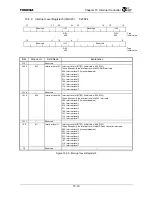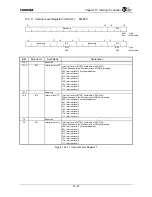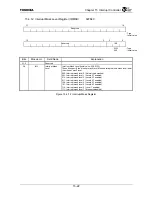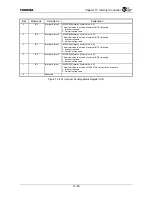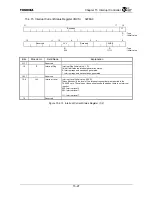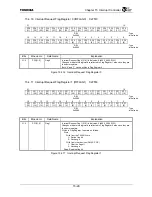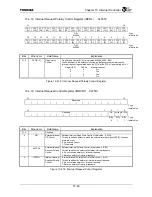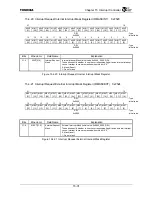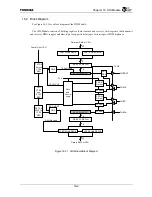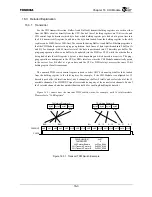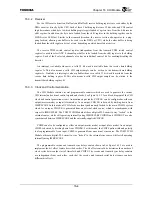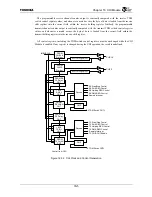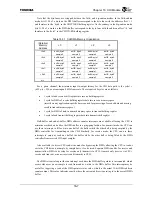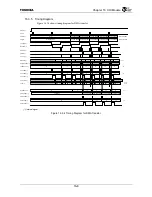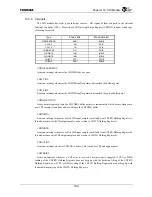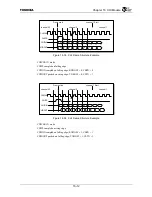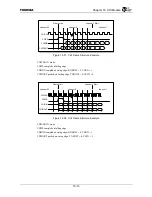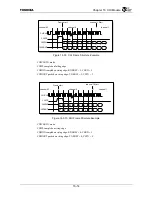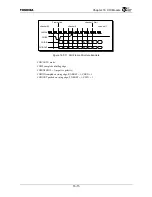
Chapter 16 CHI Module
16-1
16. CHI
Module
16.1 Characteristics
The CHI Module within the TX4925 contains holding registers, shift registers, DMA support, and other
logic to support interfacing to external full-duplex serial TDM communication peripherals, including ISDN
communication devices and PCM/TDM serial highways. The TX4925 implementation of the CHI Module is
based on the Concentration Highway Interface standard specified by Intel and AT&T, which is intended to
allow glueless interface to various TDM highways used by numerous commercial products. The TX4925
CHI Module can also be used to support an intra-system high-speed serial DMA channel within a PDA
system.
The TX4925 CHI Module utilizes a 4-signal interface consisting of clock, sync, transmit serial data, and
receive serial data. The data is organized as a TDM format, with up to 64 timeslots (nominally 8 bits each)
per frame, with a nominal frame rate of 8 kHz (8 bits
×
8 kHz
=
64 kbps nominal data rate per channel). Up
to four input timeslots and up to four output timeslots can be independently selected in each half-frame. The
CHI Module does not handle the timeslots which are not selected for input or output. The number of
timeslots and the data rate (up to 4.096 Mbps) and frame rate (up to 64 kHz, depending on the system
configuration) are programmable, providing flexibility for supporting various TDM communication
peripherals. These timeslots are commonly used to carry voice, data, or control and status information.
The CHI Module provides full-duplex DMA support for receive and transmit (two DMA channels). The
DMA buffers can be configured in a continuous (circular) buffer mode or a one-time (empty or fill, then
stop) buffer mode. Half-buffer and end-of-buffer DMA address counter interrupts are available, allowing the
CPU to minimize overhead and efficiently empty or fill half of the DMA buffer in a ping-pong fashion. The
DMA buffer size is programmable (from a minimum of 16 bytes up to a maximum of 16 Kbytes) and the
receive and transmit buffers can be configured to either reside in different memory spaces or share the same
memory space (overlapping buffers for loopback purposes or for optimum memory allocation). Also
available is a direct CPU read/write mode for bypassing the DMA, allowing the CPU to read or write the
CHI data on a sample by sample basis, if so desired.
Содержание TMPR4925
Страница 1: ...64 Bit TX System RISC TX49 Family TMPR4925 Rev 3 0 ...
Страница 4: ......
Страница 15: ...Handling Precautions ...
Страница 16: ......
Страница 18: ...1 Using Toshiba Semiconductors Safely 1 2 ...
Страница 40: ...3 General Safety Precautions and Usage Considerations 3 18 ...
Страница 42: ...4 Precautions and Usage Considerations 4 2 ...
Страница 43: ...TMPR4925 ...
Страница 44: ......
Страница 54: ...Chapter 1 Features 1 8 ...
Страница 58: ...Chapter 2 Block Diagram 2 4 ...
Страница 88: ...Chapter 4 Address Mapping 4 12 ...
Страница 226: ...Chapter 8 DMA Controller 8 58 ...
Страница 260: ...Chapter 9 SDRAM Controller 9 34 ...
Страница 480: ...Chapter 15 Interrupt Controller 15 32 ...
Страница 554: ...Chapter 19 Real Time Clock RTC 19 8 ...
Страница 555: ...Chapter 20 Removed 20 1 20 Removed ...
Страница 556: ...Chapter 20 Removed 20 2 ...
Страница 564: ...Chapter 21 Extended EJTAG Interface 21 8 ...
Страница 580: ...Chapter 22 Electrical Characteristics 22 16 ...
Страница 586: ...Chapter 23 Pin Layout Package 23 6 23 2 Package Package Type Package Code 256 pin PBGA PBGA 4L P BGA256 2727 1 27A4 ...
Страница 588: ...Chapter 24 Usage Notes 24 2 ...
Страница 590: ...Appendix A TX49 H2 Core Supplement A 2 ...

